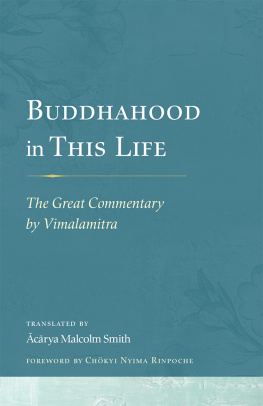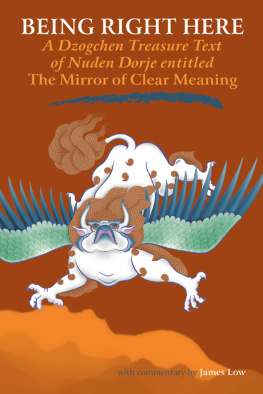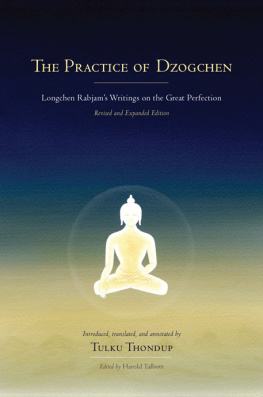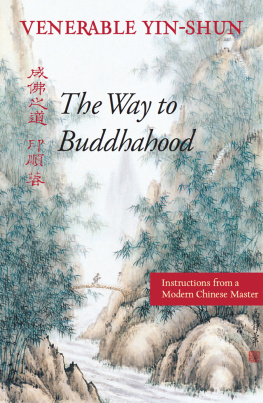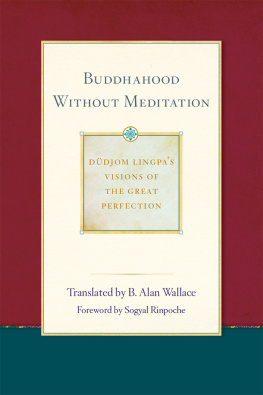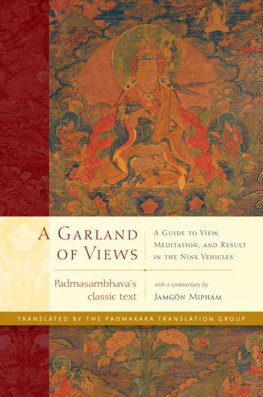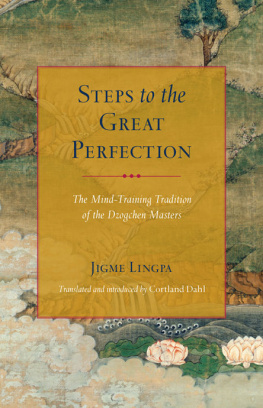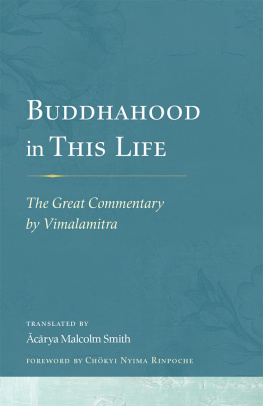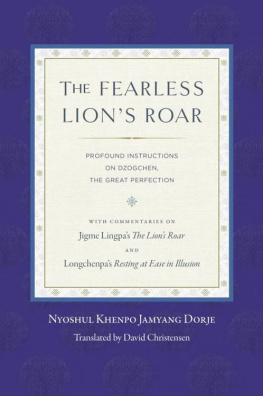
This particular text, The Great Commentary known as Buddhahood in This Life, is a remarkable summary of the Seventeen Tantras and hence provides an in-depth overview of the Great Perfection itself. The teachings of the Great Perfection were predicted to blaze forth in this dark time, and with the publication of this translation modern practitioners unable to read the original Tibetan can now benefit by clarifying their understanding and avoiding possible misinterpretations of such precious and subtle teachings.
C HKYI N YIMA R INPOCHE , FROM HIS FOREWORD

I rejoice and praise crya Malcolm Smiths direct translation from Tibetan into English of the Aural Lineage of Vimalamitra from the cycle of the Pellucid Transcendent State of the Great Perfection. Since it is certainly of great benefit to faithful practitioners of Dharma around the world, I sincerely wish that once they have realized the secret of the mind in dependence on all of the books instruction, which appear through the intimate instructions of the guru, they will be able to accomplish liberation into the body of light in one lifetime.
T ULKU D AGPA R INPOCHE
An inspired translation of one of the classics of the Great Perfection, unveiling the extraordinary tradition of the eighth-century pandit Vimalamitra. This book introduces the reader to the secret visionary instructions of thgal practice, the core of Dzokchen itself. Extensively based on the corpus of the Seventeen Tantras, the text reveals the entire path of the Great Perfection in a fluid and inspiring style that carefully follows the original.
J EAN -L UC A CHARD , AUTHOR OF T HE S IX L AMPS
ABBREVIATIONS
| DD: | Dorje Drag edition of the Dgongs pa zang thal |
| GZ: | Dgongs pa zang thal |
| N: | Nechung edition of the Dgongs pa zang thal |
| NB: | Nyi ma bum |
| ADZ: | Adzom edition of the Seventeen Tantras |
| TDD: | Tshig don mdzod |
| Tsham: | Mtsham brag edition of the Rnying ma rgyud bum |
FOREWORD

T HE TEACHING of the Great Perfection is considered the highest of all the Buddhas teachings, the summit of the nine vehicles in a context where highest means the closest and most essential way to directly know reality, which is the purpose of all of his teachings.
The author of the present book is Vimalamitra, one of three main masters who brought the Great Perfection teachings to Tibet. Padmasambhava described him in these words:
The master Vimalamitra was an emanation of the Great Compassionate One. The Indian Dharma king Aoka had a daughter named Dharmabodhi, whose ravishing beauty was like that of a divine maiden. Once, while sleeping in a flower garden, she dreamed that an extremely handsome white man came and anointed her with a full vase of nectar. As the liquid passed down through the crown of her head, her body was filled with bliss. After twenty-one days, she gave birth without any discomfort to a baby boy. Thinking of the dreadful shame to have a child without a father, she abandoned the baby in the desert. Later she returned to look for the child and found him sitting with his eyes wide open and alert. Feeling compassion for the baby, she took him home and nurtured him. Month after month and year by year, the boy grew much faster than other children. When only five years had passed, he went to the monastery of Nland. With the paitas there, he studied the five sciences and the three collections of scripture. In particular, he became learned in all the tantras. He took ordination from the master r Siha and was given the name Vimalamitra, flawless renown. Following that, he became the most eminent among the learned paitas. He acted as the officiating priest for the wheel-turning Dharma king and resided in the monastery of Vikramala in the company of five hundred paitas.
Invited by the Tibetan monarch, Vimalamitra came to Tibet during the time of Padmasambhava. In addition to promulgating many teachings of stra and tantra, he was renowned for translating the famed Seventeen Tantras and for promulgating the secret instructions connected with them. After many years, having attained rainbow body, he left Tibet for Mount Wutai in China. It is now held that every hundred years he sends an emanation out into the world in order to spread and rectify the teachings of the Great Perfection.
The text translated here comes from the well-known treasure cycle called the Gongpa Zangthal, which was revealed by Rigdzin Gdem, one of the five great treasure-revealing kings. Gongpa Zangthal is an abbreviation that could literally be translated as the teachings that directly reveal the realization of the primordial Buddha Samantabhadra. Its four volumes contain incredibly profound teachings on the entire path according to the Great Perfection. Authored by no other than Vimalamitra himself, this particular text, the Great Commentary known as Buddhahood in This Life, is a remarkable summary of the Seventeen Tantras and hence provides an in-depth overview of the Great Perfection. Vimalamitra arranges the teachings in eleven topics that cover all aspects related to the basis, the path, and the result. It is intended for those who have received the empowerments, reading transmissions, and instructional guidance of the Great Perfection in general and the Gongpa Zangthal cycle in particular.
The teachings of the Great Perfection were predicted to blaze forth in this dark time, and with the publication of this translation, modern practitioners unable to read the original in Tibetan can now benefit by clarifying their understanding and avoiding possible misinterpretations of such precious and subtle teachings. May it bring great blessings to this and future generations!
Chkyi Nyima Rinpoche
Ka-Nying Shedrub Ling Monastery,
Boudhanath, Nepal
INTRODUCTION

Homage to the Adibuddha, Samantabhadra
T HE GREAT COMMENTARY on Attaining Buddhahood in This Life, known simply as the Great Commentary (Grel tig chen mo), is an important Tibetan Buddhist text outlining the key teachings of the Seventeen Tantras of the intimate instruction class of Great Perfection tantras.
The Great Perfection teachings, known as Dzokchen (rdzogs chen) in Tibetan, are considered to be the ultimate view and practice of the Tibetan Buddhist school known as Nyingma (rnying ma), or Ancients, so called because they follow the texts and teachings of the early transfer (snga gyur) of Buddhism to Tibet.
Historical Background
The Great History (Lo rgyus chen mo) found within the Heart Essence of Vimalamitra (Bi ma snying thig) tells us that the teachings of the Great Perfection were brought to Tibet in the late eighth and early ninth centuries, principally by three disciples of the Indian master r Siha: Padmasambhava, Vimalamitra, and the Tibetan translator Vairocana. Vairocana is responsible for introducing two of the three main divisions of the Great Perfection teachings, which came to be known as the mind series (
Next page
